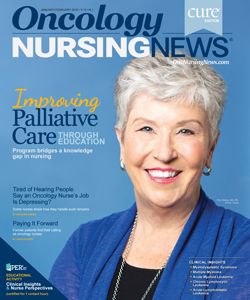Oral Oncolytics Are Changing Nursing Practice
“We are in the midst of a real paradigm change within our specialty.”
In assuming the new role of editor in chief of Oncology Nursing News®, I find myself thinking about the future. I challenge my fellow nurses to do the same.
Many years ago, I remember hearing a speaker tell the audience that just as you think back on what cancer care was like when you started your career and you consider all the changes that have occurred since then, you must assume that as you look forward, an equivocal amount of change will ensue. The take-home message is clear: Tomorrow’s cancer care and cancer nursing will not look like it does today. It is critical, then, that we take a proactive stance toward this evolution in care rather than a reactive one. Case in point: drug delivery of antineoplastics.
The significant trend toward the oral formulation of oncolytics has already started. Most likely, we are just realizing the tip of the iceberg. As of 2013, 30% of existing anticancer agents and another third of those in the development pipeline are orally formulated.1-3 With the administration of oral therapies comes the shift of drug delivery responsibility from the oncology nurse to the patient with cancer. We are in the midst of a real paradigm change within our specialty.
Patients are now expected to take their medications independently outside of the healthcare environment and selfmanage adherence and toxicity management. Less contact with the cancer care team correlates with decreased potential for face-to-face problem solving.
Overall adherence to oral oncolytics is estimated to be between 50% and 90%.4 How does this contribute to response rates and outcomes of clinical trials?5 The reality is that we don’t really know how patients are managing their oral regimens. We have only cursory evidence of the reasons why patients do not take their medications as prescribed. Is it cost, poor memory, misunderstanding, literacy issues, or concerns about adverse events? Until we have assays that measure drug concentrations rather than relying on drug diaries and pill counts, there is no preferred way to measure adherence. Additionally, we must consider the phenomenon of overadherence. What about those who believe more is better? How does this contribute to toxicity burden and organ impairment? Although these “big picture” adherence issues are scrutinized and researched, we need to consider the following:
Don’t ask, “Are you having trouble taking your medications?” but rather, “What problems are you having?” Assume patients are not taking their medications 100% of the time. In one infusion center I visited, new patients were required to pick a “medication partner.” Usually this was an immediate family member or close friend whose designated role was to collaborate with the patient on their oral regimen adherence.
Nurses working with patients receiving oral oncolytics need to identify methods to keep in close contact with patients via email and video chat options. Nurse navigators are in a unique position to champion this effort. A recent review of interventions to improve oral chemotherapy safety and quality revealed that 2 of the interventions with statistically significant improvements were nurse coordinated; namely, implementing nurse phone calls within the first few days of treatment initiation and having standardized toxicity-management protocols that codified interventions for problems so nurses can provide consistent advice to patients.6
In thinking about the future, we must also anticipate changes to the role of the ambulatory chemotherapy nurse. As infusion chair numbers fall, nurses may be asked, or expected, to assume the role of adherence nurse. The historic ambulatory medical oncology nurse role will most likely evolve from that of administrator to coach.
Novel trends in cancer therapeutics are happening here and now. We must embrace opportunities to consider new ways to nurse. These include fine-tuning skill sets for our roles as advocates, motivators, and problem-solvers within the mosaic of highly complex cancer care.
REFERENCES1. Geynisman DM, Wickersham KE. Adherence to targeted oral anticancer medications. Discov Med, 2013;5(83):231-241. discoverymedicine.com/Daniel- M-Geynisman/2013/04/25/adherence-to-targeted-oral-anticancer-medications. Accessed December 11, 2018.2. Hershman DL. Sticking to it: Improving outcomes by increasing adherence. J Clin Oncol, 2016;34(21):2440-2443. doi: 10.1200/JCO.2016.67.7336.3. IMS Institute for Healthcare Informatics. Global Oncology Trend Report: A Review of 2015 and Outlook to 2020. Parsippany, NJ: IMS Institute for Healthcare Informatics; 2016. morningconsult.com/wp-content/uploads/2016/06/IMSInstitute- Global-Oncology-Report-05.31.16.pdf. Published June 2016. Accessed Dec. 12, 2018.4. Paolella GA, Boyd AD, Wirth SM, Cuellar S, Venepalli NK, Crawford SY. Adherence to oral anticancer medications: Evolving interprofessional roles and pharmacist workforce considerations. Pharmacy (Basel). 2018;6(1). doi: 10.3390/pharmacy6010023.5. Cardoso E, Csajka C, Schneider MP, Widmer N. Effect of adherence on pharmacokinetic/ pharmacodynamic relationships of oral targeted anticancer drugs. Clin Pharmacokinet. 2018;57(1):1-6. doi: 10.1007/s40262-017-0571-z.6. Zerillo JA, Goldenberg BA, Kotecha RR, Tewari AK, Jacobson JO, Krzyzanowska MK. Interventions to improve oral chemotherapy safety and quality: a systematic review. JAMA Oncol. 2018;4(1):105-117. doi: 10.1001/ jamaoncol.2017.0625.

Innovative Program Reduces Nurse Turnover and Fosters Development
Published: September 12th 2024 | Updated: September 12th 2024The US Oncology Network (The Network) has developed one of the most comprehensive programs in the nation to support the professional development and retention of new oncology nurses.


